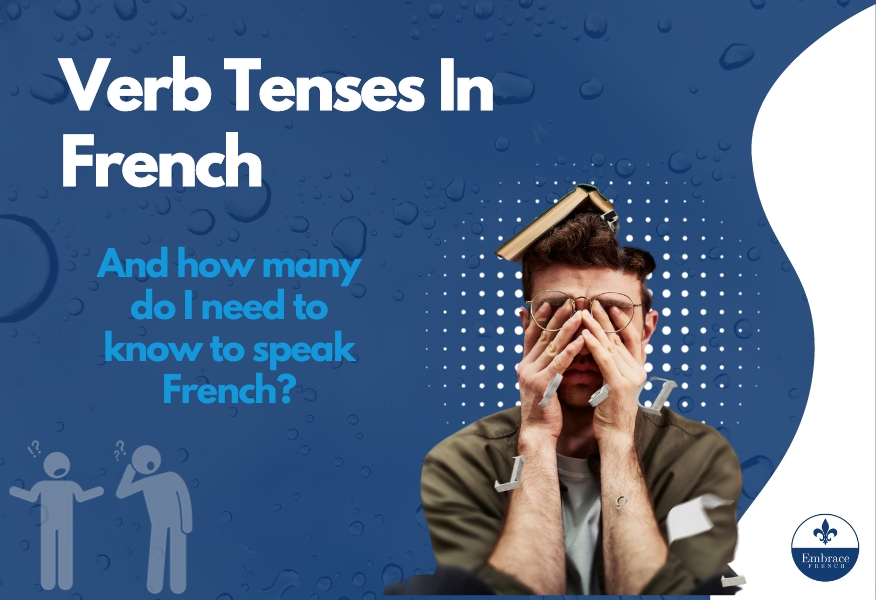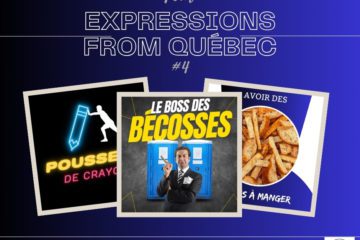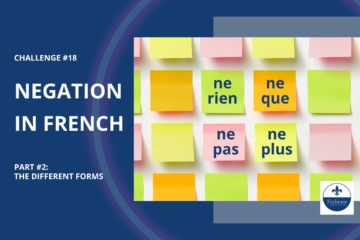Why so many verb tenses in French?
And how many do I need to know to be able to speak French.
CHALLENGE #10

The hardest part of learning French is often not learning new words, but conjugating verbs.
To compare the level of difficulty between French and English, let me tell you this anecdote about when I was learning English as a child. When my teacher told me that for the future tense, all we had to do was to add « will » in front of the verb, I had my doubts, because it was so simple. In other words, I kept waiting for her to say « I’ve got you! But no, that’s obviously not the rule! » Since she never said it, I asked her about the other verb tenses, and I was lost for understanding. Everything was so easy and simple that, in my childish head, I was convinced that she was making fun of me and that, with each of my questions, she was simply continuing her joke!
So, if I didn’t believe that conjugation could be so simple, my heart goes out to you in the incredible challenge of French verb tenses!
How many verb tenses are there?
In French, there are 18 verb tenses grouped into four families.
Indicatif: présent, imparfait, passé composé, plus-que-parfait, passé antérieur, passé simple, futur simple, futur proche, futur antérieur
Conditionnel: présent, passé première forme, passé deuxième forme
Subjonctif: présent, passé, imparfait, plus-que-parfait
Impératif: présent, passé
If you’d like to find out how to conjugate verbs in all these tenses, I suggest this comprehensive tool: https://leconjugueur.lefigaro.fr/
Do I need to know all the verb tenses to speak French?
You’ll be relieved to know that you don’t need to know all the verb tenses to express yourself and be understood in French.
There are verb tenses, such as the subjonctif plus-que-parfait, that were in constant use in the time of Louis XIV, and are hardly used at all today.
The good news is that eight verb tenses are absolutely necessary to communicate in French. The others are relevant to know, but mostly to be able to recognize them in the texts you may have to read.
The eight essential verb tenses in French
These are mostly indicatif verb tenses, but not only. To have conversations in French, to be understood and to read all kinds of texts, you need to master:
Indicatif: présent, imparfait, passé composé, futur simple, futur proche
Conditionnel: Présent
Subjonctif: présent
Impératif: présent
Do I have to learn them all at the same time?
Because conjugation in French is far from simple, I advise you to tackle each verb tense one after the other. If you study them all at the same time, I’m afraid the little differences between each one will just become a gigantic mush of knowledge in your brain.
Here’s my suggested learning order:
Step #1 (present): Indicatif présent
Step #2 (past): Indicatif imparfait et indicatif passé composé
Step #3 (future): Indicatif futur simple et indicatif futur proche
Step #4 (hypothetical): Conditionnel présent
Step #5 (slightly more difficult hypothetical): Subjonctif présent
Step #6 (giving orders): Impératif présent
For levels C1 and C2
Although the eight verb tenses I’ve just mentioned will make it easy for you to express yourself in French, if you’re aiming for levels C1 and C2 in French, I suggest you add these verb tenses to your learning.
Step #7 (the past before the past): Indicatif plus-que-parfait
Step #8 (the future before the future): indicatif futur antérieur
Step#9 (the hypothetical past): Conditionnel passé première forme
What is the use of each verb tense?
In French, conjugation is complex because it’s such a precise language. In fact, simply by using the right verb tense, even before the end of your sentence, people will know the point in time of what you’re talking about.
Here’s a brief summary of the purpose of each of the eight verb tenses you absolutely must know in French:
Indicatif présent
The indicatif présent is the most frequently used verb tense in French, and is used to describe what is happening now or in general, as well as general truths. Mastering the present tense is essential for building a solid foundation in French.
Use of the indicatif présent:
- Describing current actions: “Je mange une pomme” (I am eating an apple).
- Expressing general truths or permanent facts: “Le soleil se lève à l’est.” (The sun rises in the east.)
- Indicating habitual or regular actions: “Je fais du sport tous les matins.” (I exercise every morning.)
- Talk about planned future projects: “Je prends l’avion demain.” ( I am taking the plane tomorrow.)
Indicatif imparfait
The indicatif imparfait, often referred to simply as « the imparfait », is used to describe past actions not delimited in time, past habits or descriptions. The imparfait is often used in conjunction with the passé composé to describe an ongoing action (imparfait) that has been interrupted by a one-off action (passé composé). For example: » Je lisais un livre quand le téléphone sonné » (I was reading a book when the telephone rang).
Use of the imparfait:
- Description of actions taking place in the past: “Je lisais un livre quand le téléphone a sonné”. (I was reading a book when the phone rang.)
- Description of past habits: “Chaque jour, il allait au parc.” (Every day, he used to go to the park.)
- Description of past circumstances, conditions or contexts: “Il faisait beau, les oiseaux chantaient.” (The weather was nice, the birds were singing.)
- Description of past states or feelings: “Il était fatigué après une longue journée de travail.” (He was tired after a long day of work.)
Indicatif passé composé
The indicatif passé composé, or simply « the passé composé », is a verb tense used to describe actions in the past that have been completed or that took place at a specific point in time. In other words, actions for which we have an idea ( however vague sometimes) of their beginning as well as their end.
As its name suggests, it’s made up of two words: the auxiliary (être or avoir) + the participe passé of the verb in question.
Use of passé composé:
- Describing specific, completed past actions: “Hier, j’ai mangé une pizza.” (Yesterday, I ate a pizza.)
- Describing recent events: “J’ai fini mon livre il y a cinq minutes.” (I finished my book five minutes ago.)
- Talking about past actions that took place one after the other: “D’abord, j’ai pris le train, puis j’ai visité le musée.” (First, I took the train, then I visited the museum.)
- Describing events that took place in the near or distant past: “J’ai visité Montréal l’été dernier.” (I visited Montreal last summer.)
Indicatif futur simple
The indicatif futur simple, or simply « the futur simple », is used to describe actions or events that will take place in the future. It is generally used to express predictions, plans, intentions or actions that will take place after the present moment.
Use of futur simple:
- Express future actions or events: “Demain, nous irons au cinéma.” (Tomorrow, we will go to the cinema.)
- Making predictions: “Il fera beau en fin de semaine.” (The weather will be nice this weekend.)
- Talking about projects or intentions: “Je travaillerai sur ce projet demain.” (I will work on this project tomorrow.)
- Making promises or commitments: “Je t’aiderai avec tes devoirs.” (I will help you with your homework.)
Indicatif futur proche
The indicatif futur proche, also known as the “futur immédiat”, is a verb tense used to talk about actions that will take place in the very near future. It is more informal than the futur simple and is often preferred in everyday conversation, mainly because it is easier to conjugate than the futur simple. This is because this future tense is formed using the verb « aller” (to go) in the present tense, followed by the infinitive of the main verb. So, if you know how to conjugate the verb « aller” (to go) in the present tense, you can use this verb tense to talk about anything in the future. It’s a fast, straightforward way to talk about the future without using complex conjugations.
Like the futur simple, the futur proche is used to express intentions, predictions, plans or imminent actions.
Use of futur proche:
- To express intentions and plans: “Je vais sortir avec des amis ce soir.” (I am going out with friends tonight.)
- To express predictions: “Regarde le ciel, il va pleuvoir.” (Look at the sky, it’s going to rain.)
- To speak of imminent action: “Le souper est prêt, nous allons manger maintenant.” (Dinner is ready, we are going to eat now.)
- To make spontaneous announcements: “Oh non, j’ai oublié mes clés! Je vais les chercher.” (Oh no, I forgot my keys! I’m going to get them.)
- To talk about immediate plans or decisions: “Il est tard, je vais rentrer à la maison.” (It’s late, I’m going home.)
Conditionnel présent
The « conditionnel présent » is used to express hypothetical actions, wishes, advice, polite requests, or to talk about unreal situations. It’s a verb tense that indicates that the action depends on a specific condition or circumstance. The « conditionnel présent » is often used with the following formula: « si » + imparfait + conditionnel présent. For example: “Si j’étais riche, j’achèterais une maison.” (If I were rich, I would buy a house.).
Use of conditionnel présent:
- To express hypothetical actions: “Si j’avais plus de temps, je voyagerais davantage.” (If I had more time, I would travel more.)
- To express wishes or dreams: “J’aimerais visiter Paris un jour.” (I would like to visit Paris one day.)
- To give advice or make suggestions politely: “Vous pourriez essayer ce restaurant, il est excellent.” (You could try this restaurant, it’s excellent.)
- To make polite requests: “Pourriez-vous m’aider avec mes bagages?” (Could you help me with my luggage?)
Subjonctif présent
The subjonctif présent is used in French to express subjectivity and opinion. As such, it’s used to communicate doubts, uncertainties, wishes, emotions, suggestions, advice and hypothetical actions. It’s a complex verb tense, but an important one in French, as it allows you to bring different nuances of meaning to a variety of contexts. A little trick to differentiate the subjonctif présent from the indicatif présent: the subjonctif présent is often introduced by conjunctions such as « que », « bien que », « pour que » or « il faut que ».
Use of subjonctif présent:
- Expressing wishes or desires: “Je souhaite que tu réussisses.” (I wish that you succeed.)
- Expressing doubts or uncertainties: “Il est possible que nous arrivions en retard.” (It’s possible that we arrive late.)
- Expressing emotions: “Il est content que vous veniez à la fête.” (He is happy that you are coming to the party.)
- Expressing suggestions, advice or orders: “Il faut que tu fasses tes devoirs.” (You must do your homework.)
- Expressing hypothetical actions: “Pour que cela fonctionne, il est important que tout le monde participe.” (For it to work, it is important that everyone participates.
Impératif présent
The impératif présent is a powerful tool for expressing direct action and influencing the behavior of others in a clear and precise way. It is therefore used to give orders, pseudo-suggestions or to express a wish (but a wish close to an order).
The impératif présent is only conjugated with « tu », « nous » and « vous », as it’s not possible to influence the behavior of people you’re not addressing directly.
Use of impératif présent:
- Give orders: “Ferme la porte!” (Close the door!)
- Give advice or suggestions in a direct manner: “Prends un parapluie, il pleut!” (Take an umbrella, it’s raining!)
- Make invitations or suggestions (but being almost an order): “Rejoignez-nous pour un café!” (Join us for coffee!)
Your challenge: conjugate the verb “faire” (to do)
For this challenge, I ask you to make a sentence with the verb » faire » in each of the following tenses:
1. Indicatif présent
2. Indicatif imparfait
3. Indicatif passé composé
4. Indicatif futur simple
5. Indicatif futur proche
6. Conditionnel présent
7. Subjonctif présent
8. Impératif présent
I can already hear you saying, « Wait a minute! I don’t know all these verb tenses! » I know, I’m not cruel either 😉
Click here to see the verb « faire » conjugated in all tenses.Then you can use this free online translator if you need help constructing your sentences.
Have you downloaded your free guidebook package?

You can now download a free learning package on the 20 most commonly used verbs in French, conjugated in the present tense. This set includes an ebook with all the verbs and a sentence for each person (je, tu, il, elle, nous, vous, ils, elles), an Excel file to add all the concepts from the ebook to your flashcards application and a video where you can hear me pronounce these verbs and sentences. And it’s free! Download it now!


